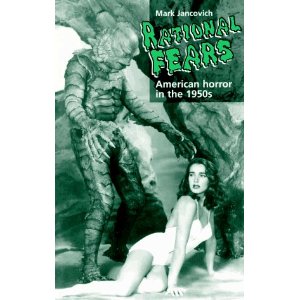 One of the highlights of reading academic treatments of the fantastic is reviewing the bibliographies that they include. Several works almost always look intriguing, and many times a handful of titles seem to be included in each bibliography making them “must read” for those looking to probe the fantastic a little deeper. For some time now I’ve been interested in Rational Fears: American Horror in the 1950s (Manchester University Press, 1996), by Mark Jancovich. I was finally able to pick up a used library copy and have been enjoying Jancovich’s discussion of the topic.
One of the highlights of reading academic treatments of the fantastic is reviewing the bibliographies that they include. Several works almost always look intriguing, and many times a handful of titles seem to be included in each bibliography making them “must read” for those looking to probe the fantastic a little deeper. For some time now I’ve been interested in Rational Fears: American Horror in the 1950s (Manchester University Press, 1996), by Mark Jancovich. I was finally able to pick up a used library copy and have been enjoying Jancovich’s discussion of the topic.
1950s horror/science fiction provided my initial foray into the fantastic when I was a young child in the 1970s and the films from this period remain a fascinating aspect of these genres for me. Yet curiously, at times these films get short shrift. Positive commentary can be found looking at the silent expressionist horror films, Universal Horror Film classics of the 1930s and 1940s, as well as the horror of the 1960s and into the 1970s with production companies like Hammer Films, and there is a growing body of analysis of more contemporary horror. But many times 1950s horror is dismissed as being somehow inferior to that of other decades.
It is in this context that Jancovich provides his analysis. He notes that critics have often dismissed 1950s horror as “trashy and sensationalist” where the films in this period are often conceived of as a form of Cold War paranoia. Jancovich challenges this assumption by arguing that:
Indeed, if there is a common feature to the majority of horror texts within the 1950s, it is not a conservative, Cold War politics, but rather a shift in emphasis away from a reliance upon gothic horror and towards a preoccupation with the modern world. Again and again, the threats which distinguish 1950s horror do not come from the past or even the actions of a lone individual, but are associated with the process of social development and modernisation. In this period, it is the process of rationalisation which is the threat, and in this way, horror texts were at least as concerned with developments within American society as they were with threats from without.
Through an exploration of various films as well as written texts and comics from the period Jancovich divides his analysis of resistance to rationality in American culture through horror into three areas of narrative, including invasion, the outsider, and crises of identity. Thankfully, his refreshing perspective leads him to conclude that 1950s horror was an important aspect of the development of the genre which continues to influence present day horror and broader popular culture. Although this volume is several years old it remains an important contribution to our understanding of a significant expression of horror/science fiction.





Glad to see I’m not the only one who liked this. It’s a good example of an intelligent academic study that should be quite accessible to non-academics.